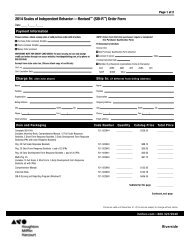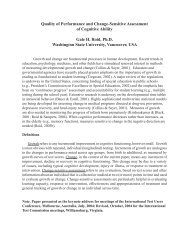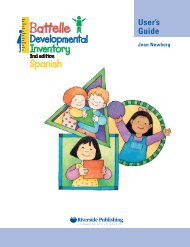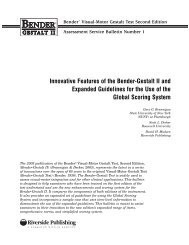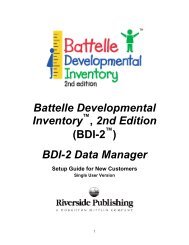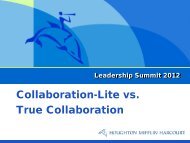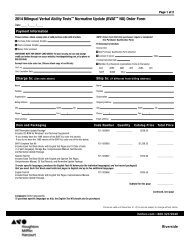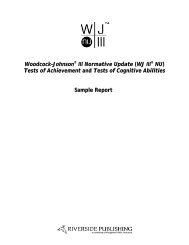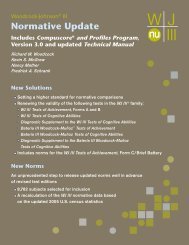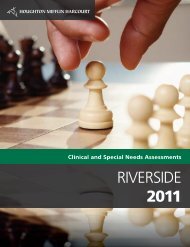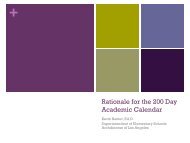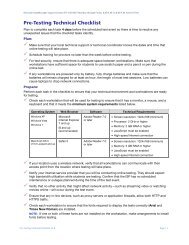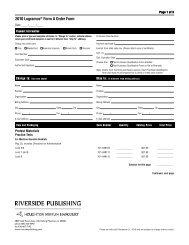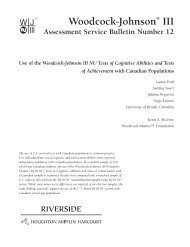Woodcock- Johnson III Tests of Cognitive Abilities - Riverside ...
Woodcock- Johnson III Tests of Cognitive Abilities - Riverside ...
Woodcock- Johnson III Tests of Cognitive Abilities - Riverside ...
Create successful ePaper yourself
Turn your PDF publications into a flip-book with our unique Google optimized e-Paper software.
Cattell, R. B. (1943). The measurement <strong>of</strong> adult intelligence. Psychological Bulletin, 40,153–193.Cattell, R. B. (1950). Personality: A systematic theoretical and factoral study. New York:McGraw-Hill.Cunningham, A. E., & Stanovich, K. E. (1991). Tracking the unique effects <strong>of</strong> print.Journal <strong>of</strong> Educational Psychology, 83, 264–274.Davidson, J., Elcock, J., & Noyes, P. (1996). A preliminary study <strong>of</strong> the effect <strong>of</strong>computer-assisted practice on reading attainment. Journal <strong>of</strong> Research in Reading,19(2), 102–110.Dehaene, S. (1997). The number sense. New York: Oxford University Press.Dehaene, S. (2000). Cerebral bases <strong>of</strong> number processing and calculation. In M. S.Gazzaniga (Ed.), The new cognitive neurosciences (2nd ed., pp. 987–998). Cambridge,Mass: MIT Press.Etscheidt, S. (2003). Ascertaining the adequacy, scope, and utility <strong>of</strong> district evaluations.Exceptional Children, 69, 227–247.Evans, J. J., Floyd, R. G., McGrew, K. S., & Leforgee, M. H. (2002). The relations betweenmeasures <strong>of</strong> Cattell-Horn-Carroll (CHC) cognitive abilities and reading achievementduring childhood and adolescence. School Psychology Review, 31(2), 246–262.Floyd, R. G., Evans, J. J., & McGrew, K. S. (2003). Relations between measures <strong>of</strong> Cattell-Horn-Carroll (CHC) cognitive abilities and mathematics achievement across theschool-age years. Psychology in the Schools, 40(2), 155–171.Floyd, R. G., McGrew, K. S., & Evans, J. J. (2008). The relative contribution <strong>of</strong> theCattell-Horn-Carroll cognitive abilities in explaining writing achievement duringchildhood and adolescence. Psychology in the Schools, 45, 132–144.Gazzaniga, M. S., Ivry, R. B., & Mangun, G. R. (1998). <strong>Cognitive</strong> neuroscience: The biology<strong>of</strong> the mind. New York: Norton.Geary, D. D., & Brown, S. C. (1990). <strong>Cognitive</strong> addition: Strategy choice and speed<strong>of</strong>-processingdifferences in gifted, normal, and mathematically disabled children.Developmental Psychology, 27, 398–406.Glazer, S. M. (1989). Oral language and literacy. In D. S. Strickland & L. M. Morrow(Eds.), Emerging literacy: Young children learn to read and write (pp. 16–26). Newark,DE: International Reading Association.Graves, M. F. (2000). A vocabulary program to complement and bolster a middle-gradecomprehension program. In B. M. Taylor, M. F. Graves, & P. van den Broek (Eds.),Reading for meaning: Fostering comprehension in the middle grades (pp. 116–135). NewYork: Teachers College Press.Graves, M. F., Juel, C., & Graves, B. B. (2004). Teaching reading in the 21st century (3rded.). Boston: Allyn & Bacon.Graves, M. F., & Watts-Taffe, S. (2002). The role <strong>of</strong> word consciousness in a researchbasedvocabulary program. In A. Farstrup & S. J. Samuels (Eds.), What research has14



